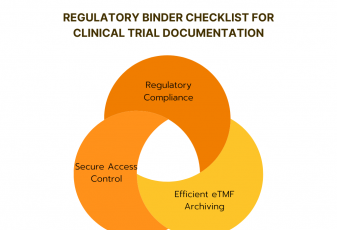With so many CROs switching to an entirely digital format for their Trial Master Files, the legislators in charge of the regulations which govern compliance with international GCP standards are being forced to adapt as well. The nature of these changes has been conducive to simplifying and fortifying the entire auditing process, not only making clinical trials safer on the whole but making sure potentially valuable information is kept accessible well into the future.
This raises a number of questions for companies interested in modernizing their auditing preparation process using digital solutions offered by a growing number of purpose-specific technology firms:
- What do regulators expect to see in the eTMF environment?
- How will regulators and auditors inspect documentation?
- What are the most common observations during an eTMF audit?
Changing the primary format of a Trial Master File to meet the needs of modern, cloud-distributed operations is a huge endeavour in and of itself when you consider the average clinical trial will last somewhere around five years, and the ease with which information can be stored in such environments has encouraged lawmakers to expand the requirements placed on CROs with respect to how long they must maintain accessible records regarding past clinical trials. Once, CROs were only expected to maintain past trial records for five years whereas now, that expectation has been lengthened to twenty-five years.
As such, choosing a vendor that is both willing and able to provide the necessary support throughout the entire onboarding process is an absolute necessity.
After integration, what can a CRO expect during the audit process? Regulators and auditors are looking for specific documents in a foreign environment and the responsibility to bring them up to speed on how any individualized or customized system works has to be built into the audit process. Those responsible for conducting external audits are on the lookout for the following essential functionalities:
- Documentation is compliant with the applicable laws and regulations;
- eTMF is updated in a timely manner and kept current;
- System is available for direct inspection upon request;
- Training for external auditors should be a smooth process which doesn’t last long;
- eTMF is inventoried and tidy, the system is validated and controlled;
- Any copies of paper records stored in the eTMF are certified.
One of the most common questions that is raised when considering these standards has to do with the meaning of “updating the system in a timely manner,” since it uses such subjective wording. The spirit of such a regulation is to ensure that companies presenting digital documentation for audit are indeed using that system as their Trial Master File and not just some kind of audit-ready repository. That means that CROs are expected to use the eTMF as their primary tool for maintaining their compliance documentation and not simply digitize their traditional Trial Master File in the days preceding some kind of audit activity.
It’s important to remember that auditors are constantly using systems produced by different vendors from different countries for different purposes, so almost every eTMF is going to have it’s own peculiarities. Additionally, the ability to perform remote audits has changed the shape of the entire process giving them access to systems from any place on the planet. In the era of cloud-oriented data storage, what do auditors expect when they access your system?
- In the European Union especially, auditors generally expect unfettered access to the eTMF system. That typically means login credentials and access to the required document in a read-only format.
- Auditors expect to be briefed on how the system works, what features may be helpful to them during their audit, and what functional idiosyncrasies need to be considered during operation.
Once the auditor is ready to dive into a CRO’s documentation, it’s important to make sure they see the absolute best practices to expedite the process, eliminate redundancy, and enhance compliance, each of which contributes to the most common reasons audits are unsuccessful. The eTMF solves all of these problems simultaneously, so long as users make a point to use each of the tools the system offers:
- Temporary placeholders give up-to-the-moment accuracy on the status of compliance documentation;
- Automatic audit trail functionality removes the need for user-generated chain of custody or chain of review documents.
- Workflows can be loaded into the system to trigger automatic notifications and action needed alerts to enhance site communication without saying a word.
In a word, the purpose of eTMF integration from the operations side is simplicity. CROs and their employees can focus more on the clinical trials process and less on the secretarial banality of documentation preparation in the face of an audit. From the monitoring side, the eTMF environment reduces the time needed to reach the physical location of the audit and makes sure that documentation is presented in a traceable and standardized fashion that highlights the CRO’s transparency and compliance.
Integrate an eTMF system and begin leveraging the potential that decentralized document management has to offer. Contact us and we will show you in details all the aspects of eTMF systems.



